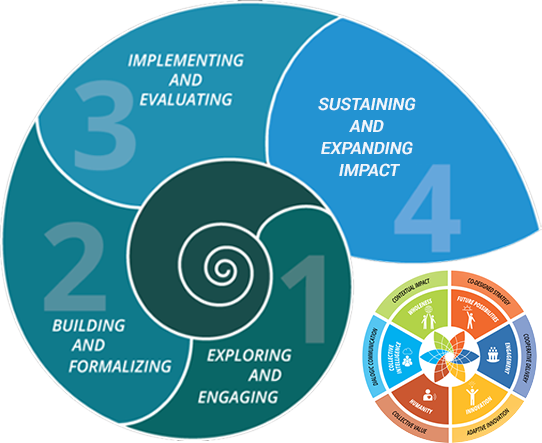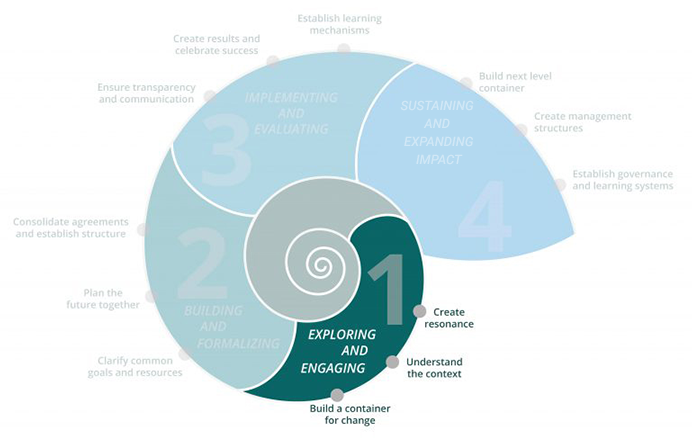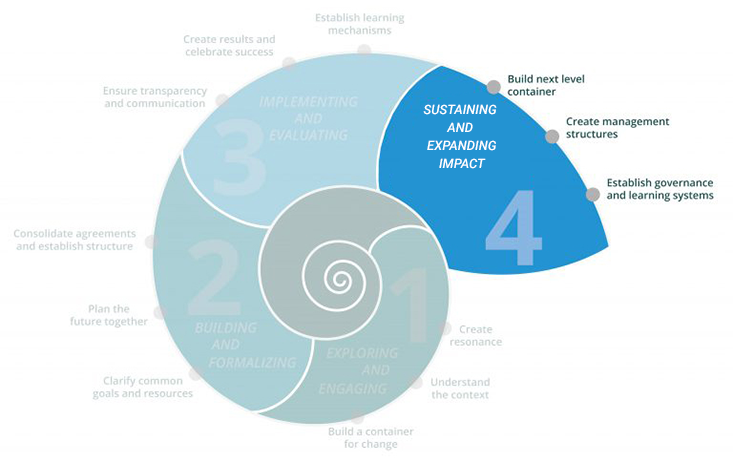The Dialogic Change Model is a guiding structure for high quality process architectures that engender a culture of collective leadership and help collaboration ecosystems deliver. Stakeholder collaboration provides a space for people to think and act together for truly transformative change. To meet these expectations, they require a well-designed process architecture.

Phase 1 is focused on raising the energy for the envisaged change and getting stakeholders interested in collaboration. It is about exploring the context of the envisaged multi-stakeholder collaboration, taking other existing initiatives and the people to potentially involve into account. This requires understanding the factors that will influence the change process, and the dynamics of the complex system in which it will take place. Talking to selected but relevant stakeholders and opinion leaders informally in this phase can help clarify and elucidate the prospects and potential obstacles for vision ahead. A small multi-stakeholder team of engaged people, called the Container, can meet at various opportunities, exchange ideas, and receive inputs from interested and knowledgeable people in this phase. Phase 1 can take a few months to about 1,5 years, depending on the complexity of issue and context.

Phase 2 is geared towards consolidating the system of stakeholder into collaboration and formalizing stakeholders' commitment to change. The objective of Phase 2 is to find an appropriate formal structure for moving an initiative forward and to build a stable collaboration ecosystem for implementation. Goals are agreed upon jointly, and roles and resources are defined. Stakeholder events include all relevant actors, initial governance structures are developed, project teams defined, and regular meetings planned. This usually leads to agreements – the signing of a contract, a Memorandum of Understanding (MoU), a project plan, or a public address in the interest of the change endeavor. The initiative shifts to a formalized process. With an official event, and an agreed–upon, written document, the stakeholder collaboration officially comes to life. It is communicated publicly and the idea is promoted more formally.
The purpose of phase 2 is to offer a sufficient degree of 'process safety' in an otherwise unpredictable and complex environment. Contributions, roles, and allocation of work as well as communication and process designs need to be agreed upon jointly. In this phase it is crucial to officially mandate the work of stakeholders in the initial Container (the core group of initiators holding process and intention for change). Commitment needs to be built beyond the initiators and complemented by a more formalized structure for implementation. In this way, the capacity of the initiative’s participants to learn and communicate is enhanced, and thus is the ability to solve difficulties. A phase 2 done well leads to the establishment of a functional collaboration ecosystem that can deliver in phase 3. Phase 2 is more likely to be successful if Phase 1 has been done thoroughly and the potential partners have a common understanding of the collaborative and dialogic approach. Phase 2 can take from one month to one year.

Phase 3 is about getting things done. In this phase, agreed-upon or recommended activities are carried out. Progress or outcomes are evaluated. Stakeholders either implement activities jointly or in a coordinated way. Most collaboration initiatives establish sequences of regular stakeholder meetings where progress is reviewed and implementation strategies are adjusted. This can include content working groups or the allocation of implementation responsibilities to different stakeholders. Monitoring and evaluation practices and iterative learning mechanisms need to be firmly established, so that joint readjustment of strategies can take place. Both structure (e.g. implementation plans, monitoring and governance structures, learning mechanisms, etc.) and process (e.g. celebrating success, sharing results, staying tuned to the joint endeavor through communication and relationship building, etc.) need to receive sufficient attention. Otherwise actors tend to drop out, lose a sense of ownership, stop implementing, get into conflicts, or start operating in silos. The skill of key actors in managing the dynamic balance between communication architectures and the joint delivery of results makes complex collaboration processes effective in implementation.
It may become apparent during the implementation that certain contextual aspects were not adequately considered or that important stakeholders were not included in the process. At this point, it is helpful to take up the approach used in Phase 1 to clarify the context fully, extend capacity building, or integrate new stakeholders into the process. The complexity of a process often becomes evident during this phase, sometimes in the form of a crisis. Crisis symptoms may include criticism from external parties, stakeholders voicing new, previously unspoken interests, negative press, counter initiatives, endless non-productive discussions, or a group of actors threatening to back out of the collaborative process. Political interests can often hold up an initiative’s development or complicate consensus-building. The higher the quality of the collaboration pattern, the better such phases of instability can be overcome. Phase 3 can take months or years, and is concluded when the agreed-upon goals have been reached.

Phase 4 is about taking the collaboration initiative to the next level, expanding or replicating its activities, and creating long-lasting structures for the envisaged change. This includes evaluating context-specific success factors and forming a change-maker community. It can include meta-collaboration, or the cooperation between different multi-stakeholder collaboration initiatives. In some cases, this requires the establishment of lasting stakeholder engagement structures and a knowledge management structure that enables key actors to transfer their experience to other change initiatives. Success needs to be adequately celebrated: participation and contributions of individual stakeholder groups should be acknowledged and appreciated. When a collaboration initiative develops further, new stakeholders need to be integrated into the process, especially when the implementation of change is handed over to a third party. Previously uninvolved actors must quickly understand the urgency and importance of an initiative and be able to emotionally connect with the larger goal. The process from a more loosely structured initiative to an institution build on the success generated in phase 3, but is not necessarily easy. Replication or institutionalization often requires a professional management structure. Role change and decision-making structures must become more efficient. Existing management and governance structures require additional legitimacy and credibility. A decisive factor for the success of this phase is that new actors are integrated and take the change intention further. Phase 4 can take indefinitely.
